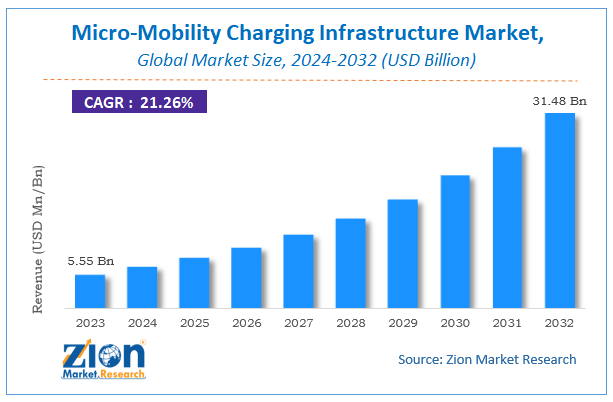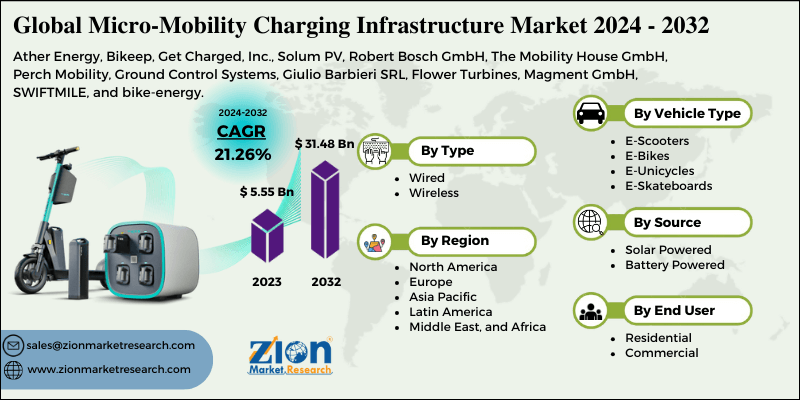Micro-Mobility Charging Infrastructure Market Size, Share, Growth Report 2032

Micro-Mobility Charging Infrastructure Market Size - By Type (Wired and Wireless), By Vehicle Type (E-Scooters, E-Bikes, E-Unicycles, and E-Skateboards), By Source (Solar Powered and Battery Powered), By End-Use (Residential and Commercial), And By Region- Global Industry Perspective, Comprehensive Analysis, and Forecast, 2024 - 2032-
| Market Size in 2023 | Market Forecast in 2032 | CAGR (in %) | Base Year |
|---|---|---|---|
| USD 5.55 Billion | USD 31.48 Billion | 21.26% | 2023 |
Micro-Mobility Charging Infrastructure Market Insights
According to a report from Zion Market Research, the global Micro-Mobility Charging Infrastructure Market was valued at USD 5.55 Billion in 2023 and is projected to hit USD 31.48 Billion by 2032, with a compound annual growth rate (CAGR) of 21.26% during the forecast period 2024-2032. This report explores market strengths, weakness, opportunities, and threats. It also provides valuable insights into the market's growth drivers, challenges, and the future prospects that may emerge in the Micro-Mobility Charging Infrastructure Market industry over the next decade.
Micro-mobility is finding lucrative applications in transport sector and other commercial enterprises. Hence, it is necessary to have strong micro-mobility charging infrastructure. Citing an instance, in December 2020, German-based micro-mobility charging service provider Tier took a loan worth Euro 250 million from Softbank for setting power network. Strong charging infrastructure is a major part of micro-mobility industry as it helps in reducing transportation costs.
With access to strong charging infrastructure becoming a best tool for massive use of small vehicles such as two wheelers, the market for micro-mobility charging infrastructure is anticipated to gain traction in the upcoming years. With thriving shared mobility industry, use of shared bicycles, electric scooters, and other modes of conveyance will be in vogue. This, in turn, will facilitate expansion of micro-mobility charging infrastructure industry in the forthcoming years. Micro-mobility sector has attracted investments worth over USD 1.2 billion and can even increase in the near future. Hence, it has become essential to have huge number of charging stations in each country along with strong infrastructure for the same.
Micro-mobility Charging Infrastructure Market: Growth Drivers
Escalating awareness pertaining to carbon emissions in atmosphere will steer micro-mobility charging infrastructure market growth in years to come. Surging oil & gas costs and increase in traffic jam on roadways will define growth of micro-mobility charging infrastructure industry over the forecast period. Awareness about flexible mode of transportation among the commuters are predicted to provide new growth avenues for micro-mobility charging infrastructure business in the years ahead.
Launching of novel micro-mobility charging ventures by service providers will benefit expansion of micro-mobility charging infrastructure industry over the coming decade. Citing an instance, in March 2021, industry players based in Paris, France, have commenced installation of 150 charging points for micro-mobility vehicles such as e-scooters and e-bicycles. The key aim of the venture is to exemplify as to how charging infrastructure will spur use of micro-mobility along with aiding reduction of pollution that can help minimize changes in seasonal cycles.
Furthermore, shifting customer trend from vehicle ownership to more user-friendly & convenient transport modes will propel market size. However, low level of awareness about shared mobility across the emerging economies and lack of legislations favoring use of micro-mobility automotive can retard growth of micro-mobility charging infrastructure market in the foreseeable future.
E-Scooters To Dominate Vehicle Type Segment Over Forecast Timeline
The segmental growth can be attributed to massive preference for these vehicles as they take less parking space and can be recharged in less time. In addition to this, use of e-scooters help in reducing traffic jams & enhance air quality. Their use can contribute massively towards green environment and can help in reducing depletion of fossil fuel reserves or petroleum reserves. With power easily generated through renewable sources of power such as solar panels, the e-scooters are likely to become more popular as an eco-friendly transportation tool in the near future. Governments of developed countries as well as emerging economies are prompting use of electric vehicles by providing users with numerous incentives. Such moves will boost the growth of e-scooters segment in the years ahead.
Residential Segment To Lead Application Landscape By 2032
The dominance of residential segment can be credited to rise in the urbanization across the world and growing preference for micro-mobility vehicles for ride sharing. In addition to this, people are becoming more aware about eco-friendly products, thereby contributing to demand for electric vehicles. Such changes in consumer buying behavior patterns have forced automotive manufacturers focus more on producing vehicles emitting less fuels. These strategic moves will further steer growth of residential segment in near future.
Micro-Mobility Charging Infrastructure Market: Report Scope
| Report Attributes | Report Details |
|---|---|
| Report Name | Micro-Mobility Charging Infrastructure Market |
| Market Size in 2023 | USD 5.55 Billion |
| Market Forecast in 2032 | USD 31.48 Billion |
| Growth Rate | CAGR of 21.26% |
| Number of Pages | 135 |
| Key Companies Covered | Ather Energy, Bikeep, Get Charged, Inc., Solum PV, Robert Bosch GmbH, The Mobility House GmbH, Perch Mobility, Ground Control Systems, Giulio Barbieri SRL, Flower Turbines, Magment GmbH, SWIFTMILE, and bike-energy. |
| Segments Covered | By Type, By Vehicle Type, By Source, By End-Use and By Region |
| Regions Covered | North America, Europe, Asia Pacific (APAC), Latin America, Middle East, and Africa (MEA) |
| Base Year | 2023 |
| Historical Year | 2018 to 2022 |
| Forecast Year | 2024 - 2032 |
| Customization Scope | Avail customized purchase options to meet your exact research needs. Request For Customization |
Regional Landscape
Asia Pacific Market To Accrue Highest Revenue By 2032
The expansion of Micro-Mobility Charging Infrastructure Market in Asia Pacific over forecast timespan is due to launching of smart city schemes in countries such as India and China. In addition to this, in June 2021, Government of India made a declaration of raising subsidies for electric two wheelers under its FAME (Faster Adoption and Manufacturing of Hybrid & Electric Vehicle) 2 scheme. With Chinese government also providing nearly 20% subsidies for purchase of new energy automotive in January 2020, the Micro-Mobility Charging Infrastructure market in Asia Pacific is anticipated to gain momentum in the upcoming years.
Competitive Landscape
Key players profiled in the study and favorably leveraging market growth include:
- Ather Energy, Bikeep
- Get Charged, Inc.
- Solum PV
- Robert Bosch GmbH
- The Mobility House GmbH
- Perch Mobility
- Ground Control Systems
- Giulio Barbieri SRL
- Flower Turbines
- Magment GmbH
- SWIFTMILE
- bike-energy
The global Micro-Mobility Charging Infrastructure Market is segmented as follows:
By Type
- Wired
- Wireless
By Vehicle Type
- E-Scooters
- E-Bikes
- E-Unicycles
- E-Skateboards
By Source
- Solar Powered
- Battery Powered
By End-Use
- Residential
- Commercial
By Region
- North America
- The U.S.
- Canada
- Europe
- France
- The UK
- Spain
- Germany
- Italy
- Rest of Europe
- Asia Pacific
- China
- Japan
- India
- South Korea
- Southeast Asia
- Rest of Asia Pacific
- Latin America
- Brazil
- Mexico
- Rest of Latin America
- Middle East & Africa
- GCC
- South Africa
- Rest of Middle East & Africa
Table Of Content
Methodology
FrequentlyAsked Questions
Escalating consciousness about GHG emissions in environment will spur micro-mobility charging infrastructure industry growth over years to come. Surging oil & gas costs and increase in traffic jam on roadways will define growth of micro-mobility charging infrastructure industry over the forecast period. Awareness about flexible mode of transportation among the commuters are predicted to provide new growth avenues for micro-mobility charging infrastructure business in the years ahead. Launching of novel micro-mobility charging ventures by service providers will benefit expansion of micro-mobility charging infrastructure industry over the coming decade. Citing an instance, in March 2021, industry players based in Paris, France, have commenced installation of 150 charging points for micro-mobility vehicles such as e-scooters and e-bicycles. The key aim of the venture is to exemplify as to how charging infrastructure will spur use of micro-mobility along with aiding reduction of pollution that can help minimize changes in seasonal cycles. Moreover, changing customer tilt from vehicle ownership to more user-friendly & convenient modes of transportation will impel market trends.
According to Zion market research report, the global Micro-Mobility Charging Infrastructure market accrued earnings worth approximately USD 5.55 B in 2023 & USD 31.48 B by 2032, with a CAGR of around 21.26% between 2024-2032.
Asia Pacific will contribute lucratively towards the global market size over the estimated timeline. The regional market surge is subject to launching of smart city schemes in countries such as India and China. In addition to this, in June 2021, Government of India made a declaration of raising subsidies for electric two wheelers under its FAME (Faster Adoption and Manufacturing of Hybrid & Electric Vehicle) 2 scheme. With Chinese government also providing nearly 20% subsidies for purchase of new energy automotive in January 2021, the Micro-Mobility Charging Infrastructure market scenario in Asia Pacific is likely to exhibit favorable outcomes in the upcoming years.
The key market participants include Ather Energy, Bikeep, Get Charged, Inc., Solum PV, Robert Bosch GmbH, The Mobility House GmbH, Perch Mobility, Ground Control Systems, Giulio Barbieri SRL, Flower Turbines, Magment GmbH, SWIFTMILE, and bike-energy.
Choose License Type
HappyClients
Zion Market Research
Tel: +1 (302) 444-0166
USA/Canada Toll Free No.+1 (855) 465-4651
3rd Floor,
Mrunal Paradise, Opp Maharaja Hotel,
Pimple Gurav, Pune 411061,
Maharashtra, India
Phone No +91 7768 006 007, +91 7768 006 008
US OFFICE NO +1 (302) 444-0166
US/CAN TOLL FREE +1 (855) 465-4651
Email: sales@zionmarketresearch.com
We have secured system to process your transaction.
Our support available to help you 24 hours a day, five days a week.
Monday - Friday: 9AM - 6PM
Saturday - Sunday: Closed







